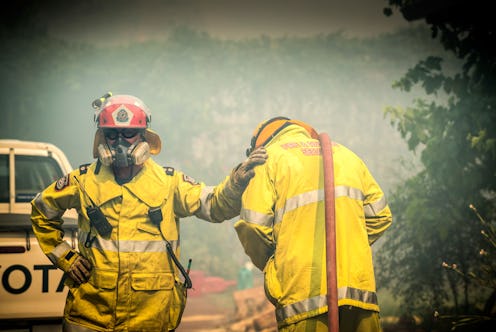News
5 Apocalyptic Findings From Obama's Climate Report
Uh-oh. On Tuesday, the White House issued its third National Climate Assessment, a thorough report four years in the making on the effects of climate change so far and how it will likely affect the United States in the future. It's a grim read, and includes the prospect of increased flooding in coastal lowlands; a longer and more intense wildfire season; torrential rains; and extinction of "iconic" species, to name some. The list is long and biblical. Even more terrifyingly, the report points out that the changes we've seen so far have been caused by a temperature rise of less than two degrees Farenheit since 1895.
In a statement released by the White House to accompany the report, the Obama Administration called for an urgent response to the report's discoveries. "The findings in this National Climate Assessment underscore the need for urgent action to combat the threats from climate change, protect American citizens and communities today, and build a sustainable future for our kids and grandkids," the statement read.
The report itself is a hefty yet morbidly-fascinating read, presented in a very cool, interactive web-page. It's worth having a bit of a play around on there, but if you don't have time to plow through the whole thing, here are its key takeaways.
1. IT REALLY IS OUR FAULT
There's no getting away from it. Yup, there are naturally-occurring factors — such as the sun and volcanoes — that could contribute to global warming, but the rapidity of the warming that has taken place over the last 50 years is basically down to us.
Multiple lines of independent evidence confirm that human activities are the primary cause of the global warming of the past 50 years. The burning of coal, oil, and gas, and clearing of forests have increased the concentration of carbon dioxide in the atmosphere by more than 40% since the Industrial Revolution, and it has been known for almost two centuries that this carbon dioxide traps heat.
In fact, the data collected by the researchers suggests that if it weren't for humans the earth's temperature would actually have dropped slightly in the last half-century.
2. TEMPERATURES WILL CONTINUE TO RISE
Remember what we said about all of the horrendous effects of climate change we've seen so far being caused by a measly two degrees Fahrenheit increase in temperature? Well, over the next few decades temperatures are expected to rise another two to four degrees. And although the amount it's going to rise will change depending on whether we cut down emissions or not, it's going to rise either way.
These two graphs show predicted temperature changes based on two different models of figuring out what that rise might be. On both graphs, the red line shows the predicted temperature rise if emissions continue to increase at the current rate. The blue line of the top graph assumes a much slower increase in emissions from today, and a significant reduction from 2050 onward. The bottom assumes immediate and significant reductions in emissions.
Best-case scenario we're looking at? A two and a half degree temperature rise by 2100.
3. TORRENTIAL RAIN IS BECOMING MORE FREQUENT
As well as getting hotter, it's also getting wetter. This graphic shows just how dramatic the change in heavy precipitation has been from 1958 to 2012.
Changes in the Southwest, Hawaii and the Northwest are considered "not larger than natural variations," but the Northeast and the Midwest in particular? Well, the figures speak for themselves really.
4. SEA LEVELS ARE RISING, BUT SO ARE WATER SHORTAGES
It seems bizarre, but although global warming is causing an abundance of water, it's also causing water shortages.
Many factors contribute to a rising sea level. Melting of ice-caps and glaciers and the fact that water expands as it warms up are the most devastating. The report notes that the global average sea level has risen by around eight inches over the past century, but the rapidity has significantly increased in recent years.
"Since 1992, the rate of global sea level rise measured by satellites has been roughly twice the rate observed over the last century, providing evidence of acceleration," the report reads.
Rising sea levels coupled with severe coastal storms are leading to increased storm surge damage, erosion and flooding, and sea levels are predicted to rise between one and four feet by the end of this century. That's just the average. In some place, the level could rise as much as 6 feet.
"The stakes are high, as nearly five million Americans and hundreds of billions of dollars of property are located in areas that are less than four feet above the local high-tide level," the report states.
But rising sea levels and torrential rains are actually contributing to water shortages. Increases in sediment and other contaminants after severe downpours is diminishing water quality. At the same time, short-term droughts are expected to become even more intense in large parts of the Southwest, the Southeast and the southern part of the Great Plains. Rising sea levels and storm surges are also starting to contaminate fresh water supplies.
5. ALLERGY SEASON IS GETTING LONGER
For the time being, there are actually a few positives to come out of global warming from a human's perspective. One of these things is longer growing seasons for farmers.
However, for those of us who suffer from allergies, this is not a good thing at all. A longer growing season coupled with higher temperatures and carbon dioxide levels means increased pollen production, which in turn can mean a lengthier and more intense allergy season.
Images: National Climate Assessment
